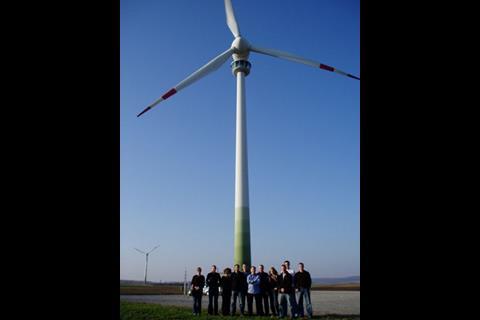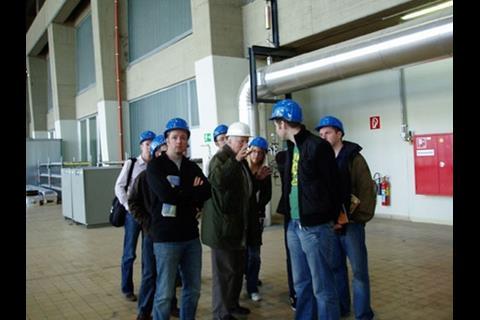ESD and Crest Nicholson team up for Austrian energy to learn about renewable energy and passivhaus design
- An examination of the thriving renewable sector in Austria which is embedding sustainable practices across the country
- A tour of energy plants in country including an energy to waste plant that is now a tourist attraction
- Lessons for the UK and full details of the offsetting strategy used for the trip
ESD recently ran a renewable energy study tour to Austria for house builder Crest Nicholson. Nine staff members from Crest Nicholson attended the tour with the aim to better understand how renewable energy projects can be implemented successfully in the UK, and to explore ways that communities can benefit from the renewable energy installations in their neighbourhood.
Austria has a commercially and politically favourable environment for renewable energy (RE) installations which has lead to the achievement of significant cost and carbon savings across the country.
Below is an analysis of the situation in Austria as compared to the UK and a description of the site visits from the tour.
Austria: commercially and politically pro renewables environment
In the past five years Austria has become an exemplary country for the speed of implementation of carbon reduction measures, specifically in the area of RE and energy efficient homes.
A feed-in tariff was introduced in 2002 meaning that each kWh of renewable electricity generated is purchased by the local power company at a set price which in differs for each RE technology.
The tariffs were high enough to make many renewable energy systems commercially viable. The uptake was more than twice a high as the government had expected, and as a result in 2006 they exceeded their renewable electricity target (which was 4%) to provide 8% of electricity from RE.
The electricity suppliers were legally obliged to purchase electricity at the feed-in tariff rates and they were allowed to recover their costs by charging the end consumer.
As a result an Austrian household paid typically about €20 to €25 extra per year for electricity.
The feed-in tariffs paid for RE installations completed by the end of 2004 (and some technologies completed by the end of 2007) for a period of 13 years were:
Due to the great uptake the feed-in tariffs were reduced in 2006 and hence the sector is now increasing at a slower rate.
Solutions in the UK
The UK equivalent to the feed-in tariffs is the Renewable Obligation Order (ROO) which requires each electricity supplier to purchase a percentage of their electricity from renewable sources.If they do not achieve this they have to purchase Renewable Obligation Certificates (ROC) for this amount. This mechanism currently means that all renewable electricity is treated the same regardless of the source of energy. In addition the current market price is approximately 4.5 p/kWh. This is additional to the general price paid for electricity.
Assuming that electricity is typically sold at 3 p/kWh, this means that the economic case for wind, geothermal energy and energy from anaerobic digestion would have similar levels of funding in the UK whereas PV, biomass CHP and biogas do not.
One would have thought that with the UK’s large wind potential and the RO providing a good economic case more turbines would have gone up in the past years. However obtaining planning permission for wind is a lot more difficult, costly and risky than in Austria.
Funding provided by local counties
The counties provide funding as well as low interest or interest free mortgage top-ups for home builders and owners who meet certain energy efficiency criteria both in new build and in retrofit. Capital funding for renewable energy measures and specific energy efficiency measures is also provided by some counties. The contribution towards capital costs tends to part or even fully fund the extra costs of the renewable technology.The funding streams were specifically designed to aid the development of renewable energy heat and hot water which is not covered through the feed-in tariffs.
(in Austria) now 80% of new build homes have solar hot water systems integrated and about 60% have wood pellet heating or are connected to a district heating network
These measures have had the impact that now 80% of new build homes have solar hot water systems integrated and about 60% have wood pellet heating or are connected to a district heating network.
Comparing the Austrian situation to the UK
The feed-in tariffs provide an environment which favours RE technologies which have high energy outputs and low capital costs. In comparison, UK policy includes the Merton Rule and the Code for Sustainable Homes.These requires a developer to deliver a certain carbon reduction through energy efficiency and low or zero carbon technologies. There is then little incentive to ensure that the renewable energy plant is running to high outputs, offsetting as much carbon as possible.
This is particularly the case as the UK equivalent feed-in mechanism, the ROCs, cannot be claimed where renewables have been installed under the Code for Sustainable Homes.
In contrast to this, the high feed-in tariffs in Austria provide a commercial environment in which high outputs and easy maintenance/repair are encouraged, as the funding is provided in direct proportion to outputs.
Site visits during the tour
Energy from wood and household waste in ViennaOver 1,000km of district heating pipelines connect a number of cogeneration plants with public, commercial and industrial buildings and homes in Vienna.
We visited two of these plants; a large (24.5MWe) Biomass CHP plant in Simmering, and the Energy from Waste CHP plant in Spittau.
Especially impressive was the success story of converting the reputation of the existing energy from waste plant in the centre of Vienna from an environmental problem (the original plant burnt down) into an environmental exemplar.
It is now one of Vienna’s top 10 tourist destinations, which must be a first for an energy from waste plant.
Through commissioning the famous artist Friedensreich Hundertwasser (who symbolised the environmental movement) to design the outer façade of the refurbishment and combining this with top environmental technology and continuous monitoring of emissions, the plant has now become famous both for its high environmental credential and for its architectural imprint.
In Vienna all recyclable waste is recycled with the remainder burned at Spittau.
Whilst Austria’s emission limits for waste incineration are already some of the most stringent values worldwide, the Spittau plant regularly stays between 70% and 99% below the permitted emission values. Indeed we witnessed very clean air and even though it was a clear summer day we could hardly see any fumes coming out of the chimney at Simmering nor at Spittau.
In the UK the planning process is still a major barrier to renewable energy. Planning authorities need to weigh local interests against the global benefits of reduced climate change when making a decision.

Vienna Energy House
We also visited the Vienna Energy House, a fantastic display centre for energy efficient building technology and detailing, located in a prominent position is one of Vienna’s busiest shopping districts.
They provided a talk about the passivhaus standards which all new homes will have to achieve in Vienna in 2011. We were told that home owners are awarded a grant of €12,000 to achieve the passivhaus standard which has resulted in the completion of around 2,500 homes to-date.
Private energy initiatives in Bruck an der Leitha
Bruck an der Leitha is a small town near Vienna which has prospered significantly from a number of renewable energy initiatives.
In an attempt to generate 100% of its renewable energy from renewables, a not–for-profit organisation was set up as a primary driver for three renewable energy technologies (biogas CHP, biomass heating and a wind park) and an MSc course in “Renewable energy in Central and Eastern Europe” has been made available.
The renewable energy plants are owned and run by local people which has resulted in the generation of around 30 jobs.
This is at a time when employment in the town is falling as a result of increased retail competition from nearby Vienna:
• A number of farmers own the biogas CHP plant and use it to deposit their waste and obtain their fertilizer (a waste product from the process).
• Forest owners have ownership in the biomass heating plant and also have a source for their waste wood.
• For the wind farm preferential share offers were made to the local community.
Involving the community in this way meant that there was little opposition. In fact the community now takes a lot of pride in what they call “their windfarm, biogas CHP and wood heating”.
The highlight of the tour was being able to climb up inside the shaft of one of the wind turbines to visit its viewing platform at a height of 60m. From there we had a great view of the local landscape which is covered with wind farms all benefiting from the Government’s forward thinking and stable policies for renewable energy.
Offsetting the emissions from the tour
The dichotomy of choosing a very carbon intensive mode of travel and flying 400 miles on a RE tour led us to investigate the feasibility of going by train.The travel time involved in this seemed unrealistic and hence we chose instead to offset all emissions from the trip. The emissions are offset through ESD’s Plan Vivo initiative: as investments in a socially beneficial forestry project. We chose gold star equivalent investment where we multiply the carbon emissions from flight by a factor of 2.6 due to the greater global warming impact at altitude resulting from radiative forcing. For a full breakdown of the offsetting scheme see the attached document.
Lessons for the UK
One may argue that there is a greater resource for renewables in Austria. However whilst this is the case for biomass (with 47% of the country covered by forest), other sources such as wind have much greater potential in the UK. In addition, whilst our biomass resource is a lot smaller than that of Austria, there is a significant resource still unexploited. In the UK the planning process is still a major barrier to RE.Planning authorities need to weigh local interests against the global benefits of reduced climate change when making a decision.
RE developers and house builders also should work with the local community, businesses and organisations, such as in Bruck an der Leitha (see case study above), to ensure that the local community and economy gets to contribute and to benefit from a successful scheme.
Downloads
ESD offsetting strategy
Other, Size 0 kb
Postscript
Authors Steffie Broer and Dave Worthington are consultants at ESD. The firm provides technical and commercial advise to property developers on renewable energy and energy efficiency solutions and sustainability. ESD also advises policy makers and businesses regarding their strategic approach and detailed policies and solutions towards addressing climate change. Visit EDS.
































2 Readers' comments